MPM732 Speech: Critical Thinking on Police Brutality in Australia
VerifiedAdded on 2023/06/14
|9
|2727
|225
AI Summary
This is a speech addressing the issue of police brutality, highlighting instances of misconduct and advocating for systemic reform. The speech employs several rhetorical strategies, including Grice's Maxims, Kipling Questions, argumentative patterns, and Dilts' logical levels, to engage the audience and emphasize the severity of the problem. It cites specific cases of police brutality in Australia, questioning the accountability of law enforcement and calling for community policing and respect for citizens' rights. The speaker underscores the importance of trust between the police and the public, warning of potential social unrest if the issues are not addressed. Ultimately, the speech urges the police system to reform and treat citizens with constitutional rights, emphasizing that action must be taken before the situation escalates.
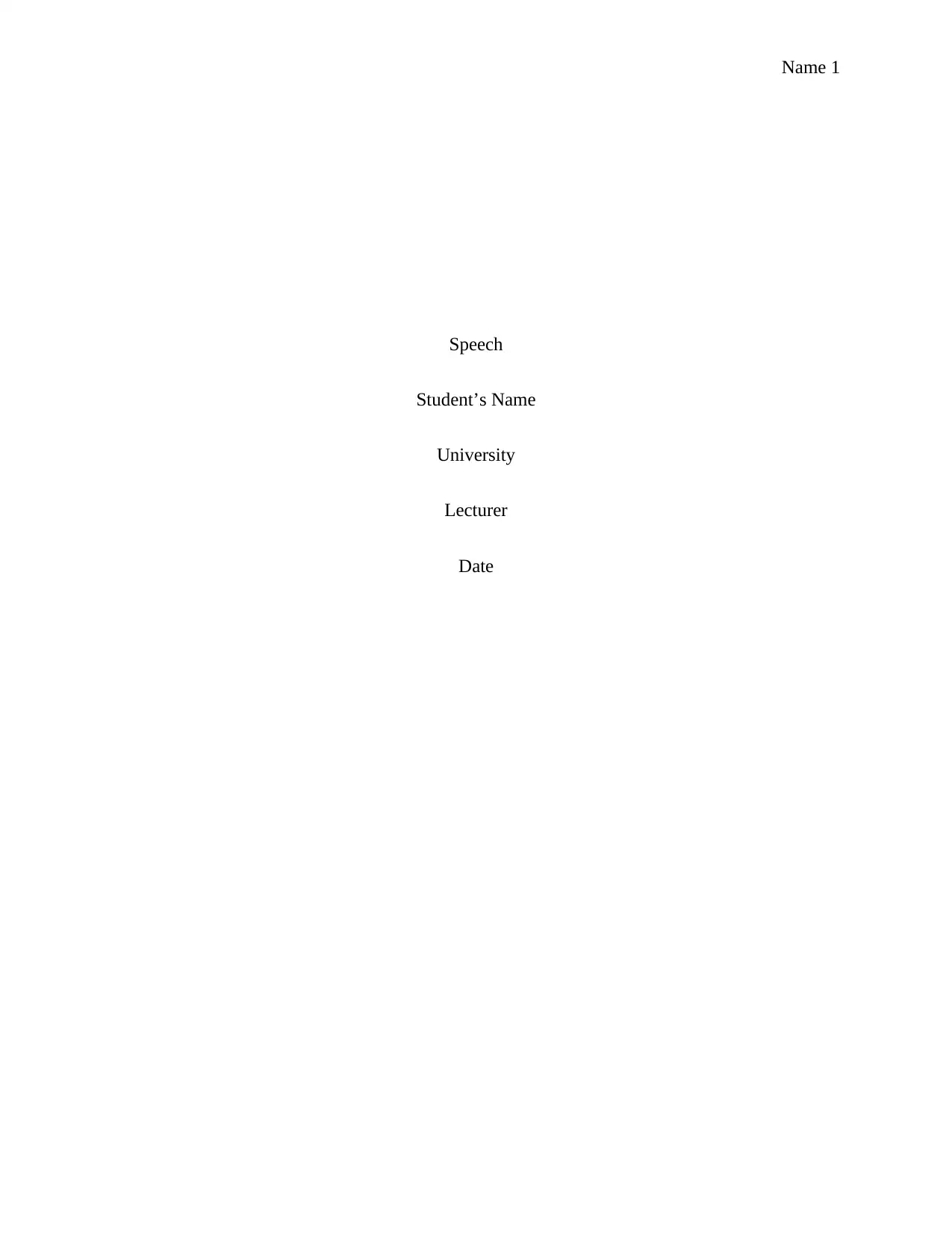
Name 1
Speech
Student’s Name
University
Lecturer
Date
Speech
Student’s Name
University
Lecturer
Date
Paraphrase This Document
Need a fresh take? Get an instant paraphrase of this document with our AI Paraphraser
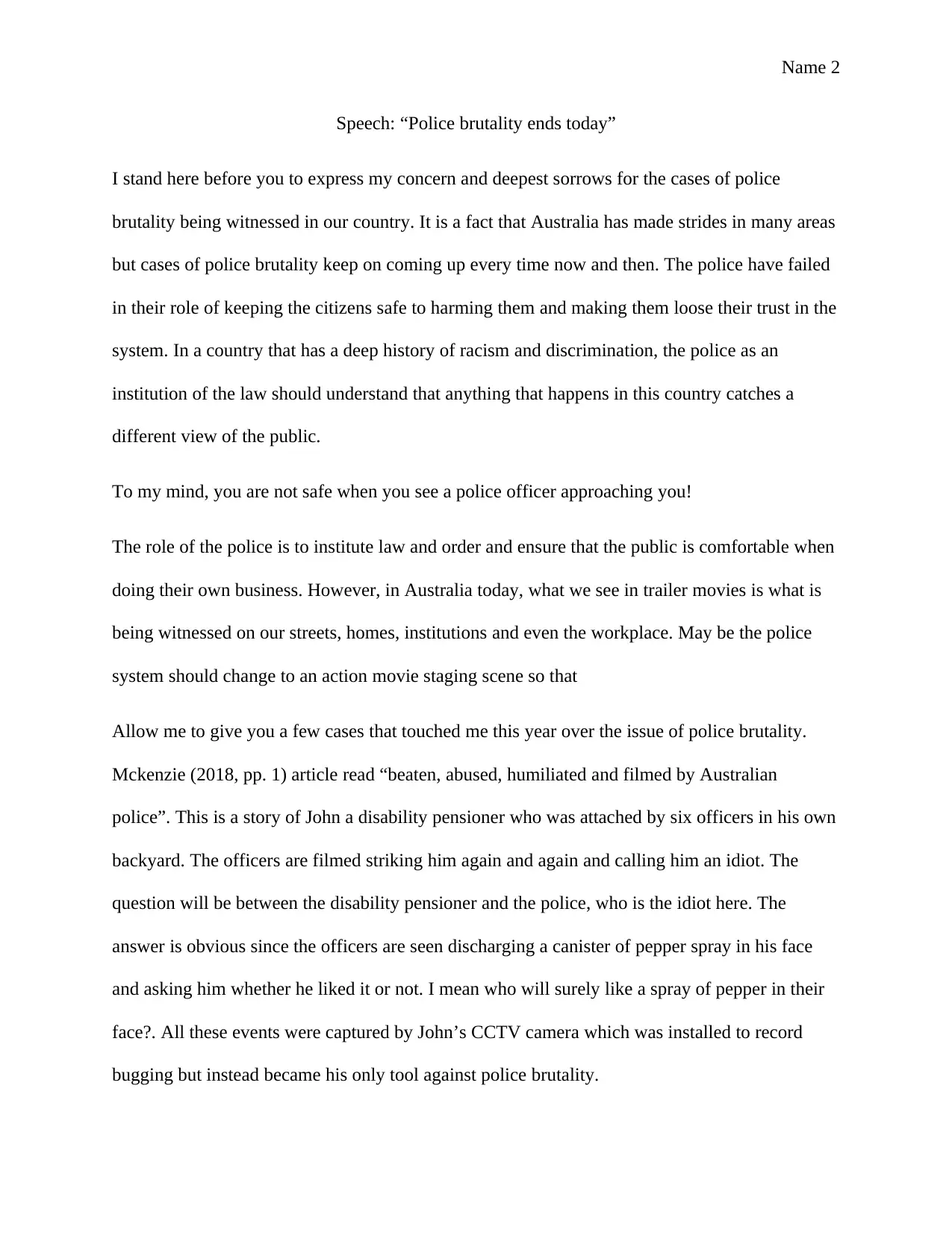
Name 2
Speech: “Police brutality ends today”
I stand here before you to express my concern and deepest sorrows for the cases of police
brutality being witnessed in our country. It is a fact that Australia has made strides in many areas
but cases of police brutality keep on coming up every time now and then. The police have failed
in their role of keeping the citizens safe to harming them and making them loose their trust in the
system. In a country that has a deep history of racism and discrimination, the police as an
institution of the law should understand that anything that happens in this country catches a
different view of the public.
To my mind, you are not safe when you see a police officer approaching you!
The role of the police is to institute law and order and ensure that the public is comfortable when
doing their own business. However, in Australia today, what we see in trailer movies is what is
being witnessed on our streets, homes, institutions and even the workplace. May be the police
system should change to an action movie staging scene so that
Allow me to give you a few cases that touched me this year over the issue of police brutality.
Mckenzie (2018, pp. 1) article read “beaten, abused, humiliated and filmed by Australian
police”. This is a story of John a disability pensioner who was attached by six officers in his own
backyard. The officers are filmed striking him again and again and calling him an idiot. The
question will be between the disability pensioner and the police, who is the idiot here. The
answer is obvious since the officers are seen discharging a canister of pepper spray in his face
and asking him whether he liked it or not. I mean who will surely like a spray of pepper in their
face?. All these events were captured by John’s CCTV camera which was installed to record
bugging but instead became his only tool against police brutality.
Speech: “Police brutality ends today”
I stand here before you to express my concern and deepest sorrows for the cases of police
brutality being witnessed in our country. It is a fact that Australia has made strides in many areas
but cases of police brutality keep on coming up every time now and then. The police have failed
in their role of keeping the citizens safe to harming them and making them loose their trust in the
system. In a country that has a deep history of racism and discrimination, the police as an
institution of the law should understand that anything that happens in this country catches a
different view of the public.
To my mind, you are not safe when you see a police officer approaching you!
The role of the police is to institute law and order and ensure that the public is comfortable when
doing their own business. However, in Australia today, what we see in trailer movies is what is
being witnessed on our streets, homes, institutions and even the workplace. May be the police
system should change to an action movie staging scene so that
Allow me to give you a few cases that touched me this year over the issue of police brutality.
Mckenzie (2018, pp. 1) article read “beaten, abused, humiliated and filmed by Australian
police”. This is a story of John a disability pensioner who was attached by six officers in his own
backyard. The officers are filmed striking him again and again and calling him an idiot. The
question will be between the disability pensioner and the police, who is the idiot here. The
answer is obvious since the officers are seen discharging a canister of pepper spray in his face
and asking him whether he liked it or not. I mean who will surely like a spray of pepper in their
face?. All these events were captured by John’s CCTV camera which was installed to record
bugging but instead became his only tool against police brutality.
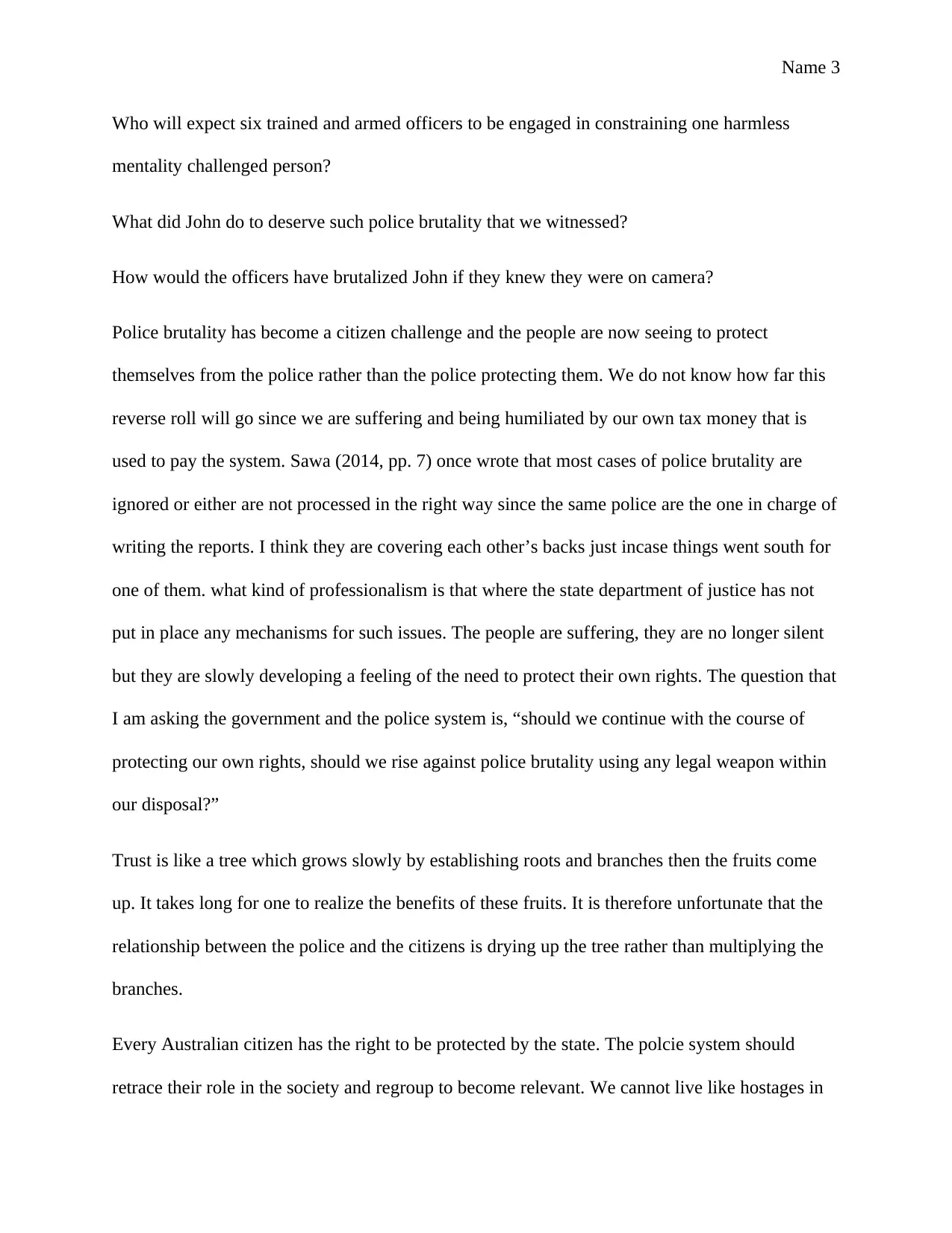
Name 3
Who will expect six trained and armed officers to be engaged in constraining one harmless
mentality challenged person?
What did John do to deserve such police brutality that we witnessed?
How would the officers have brutalized John if they knew they were on camera?
Police brutality has become a citizen challenge and the people are now seeing to protect
themselves from the police rather than the police protecting them. We do not know how far this
reverse roll will go since we are suffering and being humiliated by our own tax money that is
used to pay the system. Sawa (2014, pp. 7) once wrote that most cases of police brutality are
ignored or either are not processed in the right way since the same police are the one in charge of
writing the reports. I think they are covering each other’s backs just incase things went south for
one of them. what kind of professionalism is that where the state department of justice has not
put in place any mechanisms for such issues. The people are suffering, they are no longer silent
but they are slowly developing a feeling of the need to protect their own rights. The question that
I am asking the government and the police system is, “should we continue with the course of
protecting our own rights, should we rise against police brutality using any legal weapon within
our disposal?”
Trust is like a tree which grows slowly by establishing roots and branches then the fruits come
up. It takes long for one to realize the benefits of these fruits. It is therefore unfortunate that the
relationship between the police and the citizens is drying up the tree rather than multiplying the
branches.
Every Australian citizen has the right to be protected by the state. The polcie system should
retrace their role in the society and regroup to become relevant. We cannot live like hostages in
Who will expect six trained and armed officers to be engaged in constraining one harmless
mentality challenged person?
What did John do to deserve such police brutality that we witnessed?
How would the officers have brutalized John if they knew they were on camera?
Police brutality has become a citizen challenge and the people are now seeing to protect
themselves from the police rather than the police protecting them. We do not know how far this
reverse roll will go since we are suffering and being humiliated by our own tax money that is
used to pay the system. Sawa (2014, pp. 7) once wrote that most cases of police brutality are
ignored or either are not processed in the right way since the same police are the one in charge of
writing the reports. I think they are covering each other’s backs just incase things went south for
one of them. what kind of professionalism is that where the state department of justice has not
put in place any mechanisms for such issues. The people are suffering, they are no longer silent
but they are slowly developing a feeling of the need to protect their own rights. The question that
I am asking the government and the police system is, “should we continue with the course of
protecting our own rights, should we rise against police brutality using any legal weapon within
our disposal?”
Trust is like a tree which grows slowly by establishing roots and branches then the fruits come
up. It takes long for one to realize the benefits of these fruits. It is therefore unfortunate that the
relationship between the police and the citizens is drying up the tree rather than multiplying the
branches.
Every Australian citizen has the right to be protected by the state. The polcie system should
retrace their role in the society and regroup to become relevant. We cannot live like hostages in
⊘ This is a preview!⊘
Do you want full access?
Subscribe today to unlock all pages.

Trusted by 1+ million students worldwide
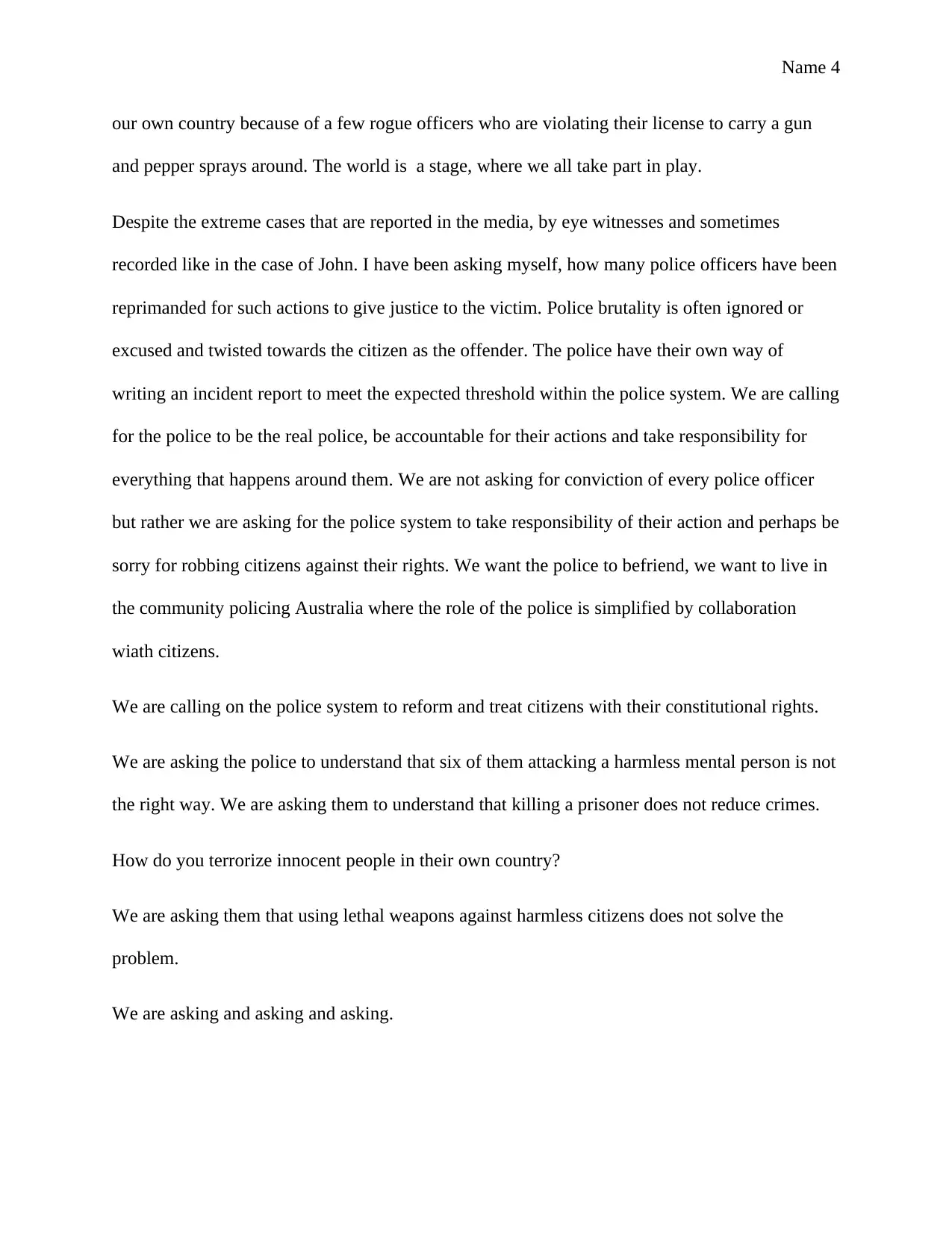
Name 4
our own country because of a few rogue officers who are violating their license to carry a gun
and pepper sprays around. The world is a stage, where we all take part in play.
Despite the extreme cases that are reported in the media, by eye witnesses and sometimes
recorded like in the case of John. I have been asking myself, how many police officers have been
reprimanded for such actions to give justice to the victim. Police brutality is often ignored or
excused and twisted towards the citizen as the offender. The police have their own way of
writing an incident report to meet the expected threshold within the police system. We are calling
for the police to be the real police, be accountable for their actions and take responsibility for
everything that happens around them. We are not asking for conviction of every police officer
but rather we are asking for the police system to take responsibility of their action and perhaps be
sorry for robbing citizens against their rights. We want the police to befriend, we want to live in
the community policing Australia where the role of the police is simplified by collaboration
wiath citizens.
We are calling on the police system to reform and treat citizens with their constitutional rights.
We are asking the police to understand that six of them attacking a harmless mental person is not
the right way. We are asking them to understand that killing a prisoner does not reduce crimes.
How do you terrorize innocent people in their own country?
We are asking them that using lethal weapons against harmless citizens does not solve the
problem.
We are asking and asking and asking.
our own country because of a few rogue officers who are violating their license to carry a gun
and pepper sprays around. The world is a stage, where we all take part in play.
Despite the extreme cases that are reported in the media, by eye witnesses and sometimes
recorded like in the case of John. I have been asking myself, how many police officers have been
reprimanded for such actions to give justice to the victim. Police brutality is often ignored or
excused and twisted towards the citizen as the offender. The police have their own way of
writing an incident report to meet the expected threshold within the police system. We are calling
for the police to be the real police, be accountable for their actions and take responsibility for
everything that happens around them. We are not asking for conviction of every police officer
but rather we are asking for the police system to take responsibility of their action and perhaps be
sorry for robbing citizens against their rights. We want the police to befriend, we want to live in
the community policing Australia where the role of the police is simplified by collaboration
wiath citizens.
We are calling on the police system to reform and treat citizens with their constitutional rights.
We are asking the police to understand that six of them attacking a harmless mental person is not
the right way. We are asking them to understand that killing a prisoner does not reduce crimes.
How do you terrorize innocent people in their own country?
We are asking them that using lethal weapons against harmless citizens does not solve the
problem.
We are asking and asking and asking.
Paraphrase This Document
Need a fresh take? Get an instant paraphrase of this document with our AI Paraphraser
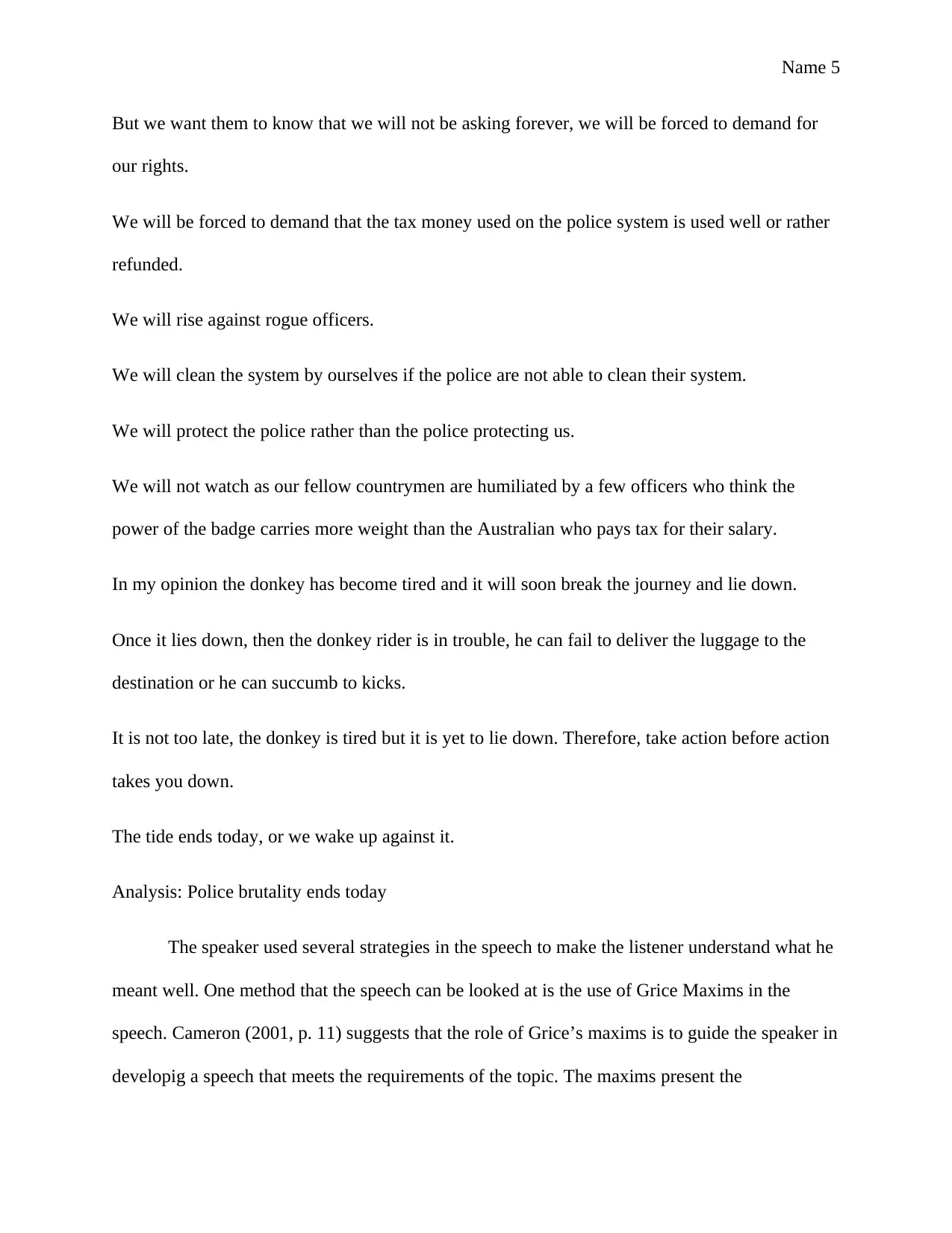
Name 5
But we want them to know that we will not be asking forever, we will be forced to demand for
our rights.
We will be forced to demand that the tax money used on the police system is used well or rather
refunded.
We will rise against rogue officers.
We will clean the system by ourselves if the police are not able to clean their system.
We will protect the police rather than the police protecting us.
We will not watch as our fellow countrymen are humiliated by a few officers who think the
power of the badge carries more weight than the Australian who pays tax for their salary.
In my opinion the donkey has become tired and it will soon break the journey and lie down.
Once it lies down, then the donkey rider is in trouble, he can fail to deliver the luggage to the
destination or he can succumb to kicks.
It is not too late, the donkey is tired but it is yet to lie down. Therefore, take action before action
takes you down.
The tide ends today, or we wake up against it.
Analysis: Police brutality ends today
The speaker used several strategies in the speech to make the listener understand what he
meant well. One method that the speech can be looked at is the use of Grice Maxims in the
speech. Cameron (2001, p. 11) suggests that the role of Grice’s maxims is to guide the speaker in
developig a speech that meets the requirements of the topic. The maxims present the
But we want them to know that we will not be asking forever, we will be forced to demand for
our rights.
We will be forced to demand that the tax money used on the police system is used well or rather
refunded.
We will rise against rogue officers.
We will clean the system by ourselves if the police are not able to clean their system.
We will protect the police rather than the police protecting us.
We will not watch as our fellow countrymen are humiliated by a few officers who think the
power of the badge carries more weight than the Australian who pays tax for their salary.
In my opinion the donkey has become tired and it will soon break the journey and lie down.
Once it lies down, then the donkey rider is in trouble, he can fail to deliver the luggage to the
destination or he can succumb to kicks.
It is not too late, the donkey is tired but it is yet to lie down. Therefore, take action before action
takes you down.
The tide ends today, or we wake up against it.
Analysis: Police brutality ends today
The speaker used several strategies in the speech to make the listener understand what he
meant well. One method that the speech can be looked at is the use of Grice Maxims in the
speech. Cameron (2001, p. 11) suggests that the role of Grice’s maxims is to guide the speaker in
developig a speech that meets the requirements of the topic. The maxims present the

Name 6
effectiveness of communication and how its relevance is achieved in social situations (Kayed &
Kitishat 2015, p. 46). When a speaker presents information to the audience, it must be organized
in a way that allows the listeners to get the right information. The speaker applied the
cooperative principle by giving a speech that met the purpose of the conversation. Since the
speech was supposed to give information to the listeners and inform them of the situation. The
cooperation principle is used throughout the speaker’s words. For example, in the beginning, the
speech starts by justifying the reason why it was being made. The speaker revolves around the
issue of police brutality quoting a few cases and writings that people have done over the issue to
illustrate the magnitude of the situation. This is cemented by the use of symbolisms when
referring trust to a tree to mean the level that the community has reached.
Another way that the speaker achieved this is the use of the maxim of relation by giving
information that was relevant to the topic as possible (Jwalapuram 2017, p. 19). Since the main
idea in the speech was police brutality, the speaker applied the maxim by contextualizing the
story in the beginning and ending with a parting shot that summarizes the whole speech. By
using the example of John followed by rhetoric questions like “Who will expect six trained and
armed officers to be engaged in constraining one harmless mentality challenged person?” and
“Did John deserve the police brutality that we witnessed?. The speaker brings the listener to the
maxim of relevance thus making the listener understandthe magnitude of the situation.
Another way that the speaker was effective in presenting the speech is the use of Kipling
Questions. This method allows the speaker to present information in a way that meets the
required needs (Eagleton 2008, p. 14). For example, the speaker used this method to present
rhetoric questions for the listener to contemplate and assess the situation. Diez & Odriozola
(2015, p. 85) suggests that the six questions allow the speaker to present questions to the
effectiveness of communication and how its relevance is achieved in social situations (Kayed &
Kitishat 2015, p. 46). When a speaker presents information to the audience, it must be organized
in a way that allows the listeners to get the right information. The speaker applied the
cooperative principle by giving a speech that met the purpose of the conversation. Since the
speech was supposed to give information to the listeners and inform them of the situation. The
cooperation principle is used throughout the speaker’s words. For example, in the beginning, the
speech starts by justifying the reason why it was being made. The speaker revolves around the
issue of police brutality quoting a few cases and writings that people have done over the issue to
illustrate the magnitude of the situation. This is cemented by the use of symbolisms when
referring trust to a tree to mean the level that the community has reached.
Another way that the speaker achieved this is the use of the maxim of relation by giving
information that was relevant to the topic as possible (Jwalapuram 2017, p. 19). Since the main
idea in the speech was police brutality, the speaker applied the maxim by contextualizing the
story in the beginning and ending with a parting shot that summarizes the whole speech. By
using the example of John followed by rhetoric questions like “Who will expect six trained and
armed officers to be engaged in constraining one harmless mentality challenged person?” and
“Did John deserve the police brutality that we witnessed?. The speaker brings the listener to the
maxim of relevance thus making the listener understandthe magnitude of the situation.
Another way that the speaker was effective in presenting the speech is the use of Kipling
Questions. This method allows the speaker to present information in a way that meets the
required needs (Eagleton 2008, p. 14). For example, the speaker used this method to present
rhetoric questions for the listener to contemplate and assess the situation. Diez & Odriozola
(2015, p. 85) suggests that the six questions allow the speaker to present questions to the
⊘ This is a preview!⊘
Do you want full access?
Subscribe today to unlock all pages.

Trusted by 1+ million students worldwide
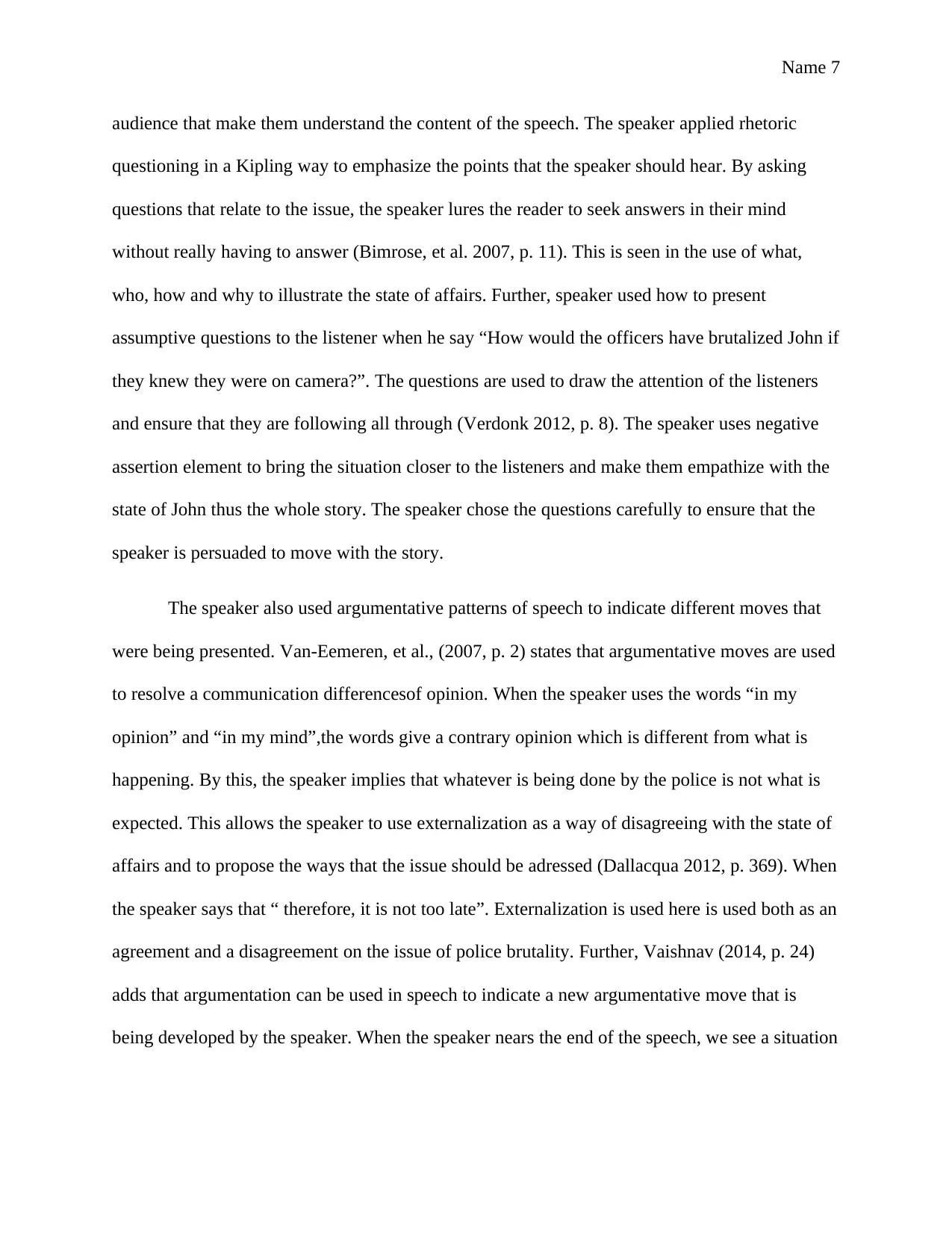
Name 7
audience that make them understand the content of the speech. The speaker applied rhetoric
questioning in a Kipling way to emphasize the points that the speaker should hear. By asking
questions that relate to the issue, the speaker lures the reader to seek answers in their mind
without really having to answer (Bimrose, et al. 2007, p. 11). This is seen in the use of what,
who, how and why to illustrate the state of affairs. Further, speaker used how to present
assumptive questions to the listener when he say “How would the officers have brutalized John if
they knew they were on camera?”. The questions are used to draw the attention of the listeners
and ensure that they are following all through (Verdonk 2012, p. 8). The speaker uses negative
assertion element to bring the situation closer to the listeners and make them empathize with the
state of John thus the whole story. The speaker chose the questions carefully to ensure that the
speaker is persuaded to move with the story.
The speaker also used argumentative patterns of speech to indicate different moves that
were being presented. Van-Eemeren, et al., (2007, p. 2) states that argumentative moves are used
to resolve a communication differencesof opinion. When the speaker uses the words “in my
opinion” and “in my mind”,the words give a contrary opinion which is different from what is
happening. By this, the speaker implies that whatever is being done by the police is not what is
expected. This allows the speaker to use externalization as a way of disagreeing with the state of
affairs and to propose the ways that the issue should be adressed (Dallacqua 2012, p. 369). When
the speaker says that “ therefore, it is not too late”. Externalization is used here is used both as an
agreement and a disagreement on the issue of police brutality. Further, Vaishnav (2014, p. 24)
adds that argumentation can be used in speech to indicate a new argumentative move that is
being developed by the speaker. When the speaker nears the end of the speech, we see a situation
audience that make them understand the content of the speech. The speaker applied rhetoric
questioning in a Kipling way to emphasize the points that the speaker should hear. By asking
questions that relate to the issue, the speaker lures the reader to seek answers in their mind
without really having to answer (Bimrose, et al. 2007, p. 11). This is seen in the use of what,
who, how and why to illustrate the state of affairs. Further, speaker used how to present
assumptive questions to the listener when he say “How would the officers have brutalized John if
they knew they were on camera?”. The questions are used to draw the attention of the listeners
and ensure that they are following all through (Verdonk 2012, p. 8). The speaker uses negative
assertion element to bring the situation closer to the listeners and make them empathize with the
state of John thus the whole story. The speaker chose the questions carefully to ensure that the
speaker is persuaded to move with the story.
The speaker also used argumentative patterns of speech to indicate different moves that
were being presented. Van-Eemeren, et al., (2007, p. 2) states that argumentative moves are used
to resolve a communication differencesof opinion. When the speaker uses the words “in my
opinion” and “in my mind”,the words give a contrary opinion which is different from what is
happening. By this, the speaker implies that whatever is being done by the police is not what is
expected. This allows the speaker to use externalization as a way of disagreeing with the state of
affairs and to propose the ways that the issue should be adressed (Dallacqua 2012, p. 369). When
the speaker says that “ therefore, it is not too late”. Externalization is used here is used both as an
agreement and a disagreement on the issue of police brutality. Further, Vaishnav (2014, p. 24)
adds that argumentation can be used in speech to indicate a new argumentative move that is
being developed by the speaker. When the speaker nears the end of the speech, we see a situation
Paraphrase This Document
Need a fresh take? Get an instant paraphrase of this document with our AI Paraphraser

Name 8
where the speech has changed to a declaration but the argumentative words “therefore” is used to
soften the stance of the speech.
Lastly, there is use of Dilts logical levels in the speech to communicate with the
audience. Dilts (2014, pp. 5) presents six logical levels that a speaker can use since each level is
a logical structure for understanding what the speaker is trying to present. The speaker applied
storytelling to capture the environment level where behavior is seen as taking place in the
environment that people operate in. The whole story takes place in the environment level since
the speaker is quoting the issues that have been taking place. This is seen in the use of
storytelling the case of John to bring the listener to the real situation of what he was referring to.
Storytelling contextualizes the speech and takes the listener back to the state of affairs when
things changed (Kalus, et al. 2005, p. 22). However, the speech is made within the belief level
where the speaker is questioning what has been happening and the factors that shape the whole
speech. The speaker ends the speech in the spirituality level where an ultimatum is issued.
Through of hyperbolism, the speaker exaggerates the situation to a donkey tired of carrying a
load and is almost lying down and refusing to move. This is the climax of the speech where the
speaker uses the spirituality level to call for action to change the situation and the issues that the
public is suffering from.
where the speech has changed to a declaration but the argumentative words “therefore” is used to
soften the stance of the speech.
Lastly, there is use of Dilts logical levels in the speech to communicate with the
audience. Dilts (2014, pp. 5) presents six logical levels that a speaker can use since each level is
a logical structure for understanding what the speaker is trying to present. The speaker applied
storytelling to capture the environment level where behavior is seen as taking place in the
environment that people operate in. The whole story takes place in the environment level since
the speaker is quoting the issues that have been taking place. This is seen in the use of
storytelling the case of John to bring the listener to the real situation of what he was referring to.
Storytelling contextualizes the speech and takes the listener back to the state of affairs when
things changed (Kalus, et al. 2005, p. 22). However, the speech is made within the belief level
where the speaker is questioning what has been happening and the factors that shape the whole
speech. The speaker ends the speech in the spirituality level where an ultimatum is issued.
Through of hyperbolism, the speaker exaggerates the situation to a donkey tired of carrying a
load and is almost lying down and refusing to move. This is the climax of the speech where the
speaker uses the spirituality level to call for action to change the situation and the issues that the
public is suffering from.
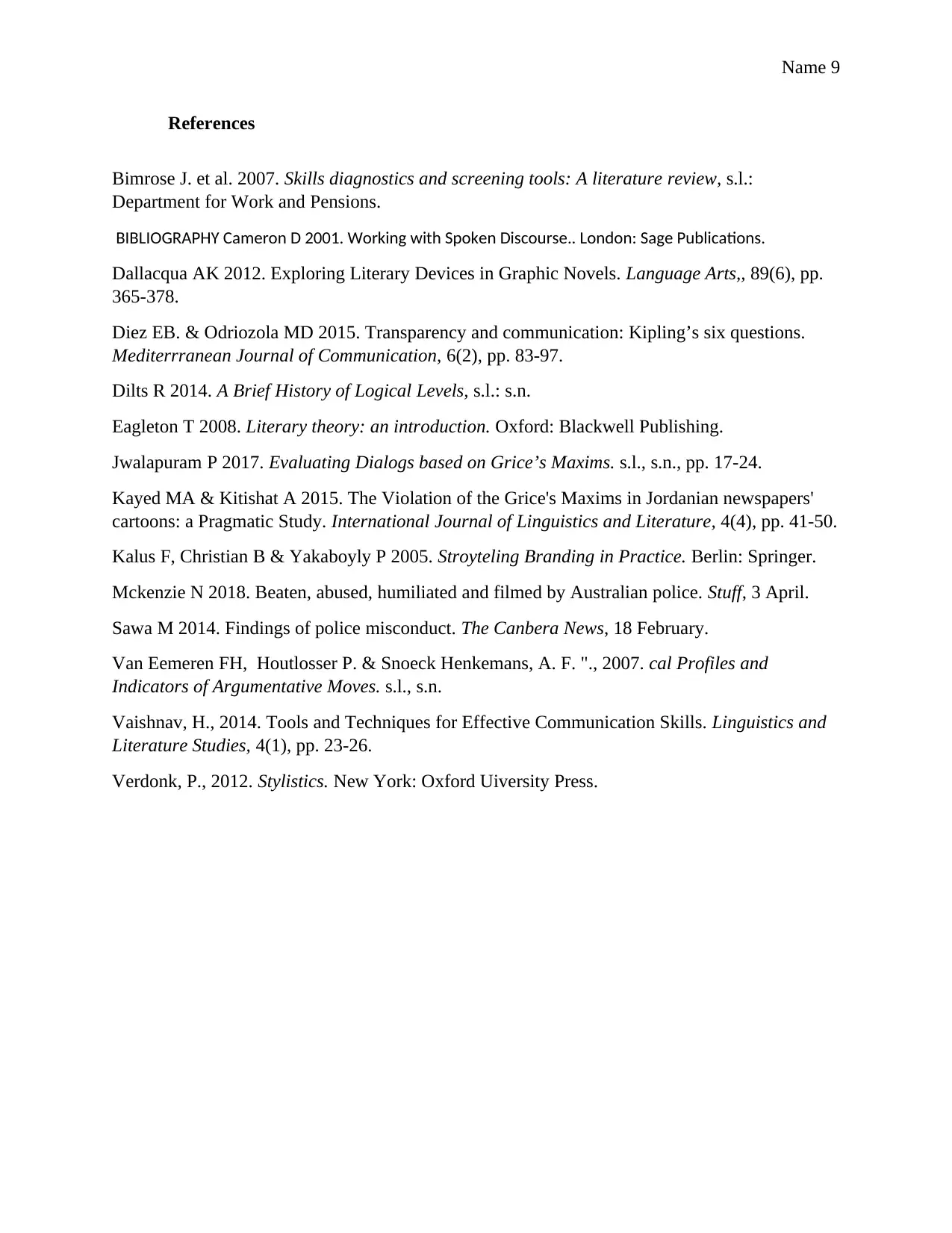
Name 9
References
Bimrose J. et al. 2007. Skills diagnostics and screening tools: A literature review, s.l.:
Department for Work and Pensions.
BIBLIOGRAPHY Cameron D 2001. Working with Spoken Discourse.. London: Sage Publications.
Dallacqua AK 2012. Exploring Literary Devices in Graphic Novels. Language Arts,, 89(6), pp.
365-378.
Diez EB. & Odriozola MD 2015. Transparency and communication: Kipling’s six questions.
Mediterrranean Journal of Communication, 6(2), pp. 83-97.
Dilts R 2014. A Brief History of Logical Levels, s.l.: s.n.
Eagleton T 2008. Literary theory: an introduction. Oxford: Blackwell Publishing.
Jwalapuram P 2017. Evaluating Dialogs based on Grice’s Maxims. s.l., s.n., pp. 17-24.
Kayed MA & Kitishat A 2015. The Violation of the Grice's Maxims in Jordanian newspapers'
cartoons: a Pragmatic Study. International Journal of Linguistics and Literature, 4(4), pp. 41-50.
Kalus F, Christian B & Yakaboyly P 2005. Stroyteling Branding in Practice. Berlin: Springer.
Mckenzie N 2018. Beaten, abused, humiliated and filmed by Australian police. Stuff, 3 April.
Sawa M 2014. Findings of police misconduct. The Canbera News, 18 February.
Van Eemeren FH, Houtlosser P. & Snoeck Henkemans, A. F. "., 2007. cal Profiles and
Indicators of Argumentative Moves. s.l., s.n.
Vaishnav, H., 2014. Tools and Techniques for Effective Communication Skills. Linguistics and
Literature Studies, 4(1), pp. 23-26.
Verdonk, P., 2012. Stylistics. New York: Oxford Uiversity Press.
References
Bimrose J. et al. 2007. Skills diagnostics and screening tools: A literature review, s.l.:
Department for Work and Pensions.
BIBLIOGRAPHY Cameron D 2001. Working with Spoken Discourse.. London: Sage Publications.
Dallacqua AK 2012. Exploring Literary Devices in Graphic Novels. Language Arts,, 89(6), pp.
365-378.
Diez EB. & Odriozola MD 2015. Transparency and communication: Kipling’s six questions.
Mediterrranean Journal of Communication, 6(2), pp. 83-97.
Dilts R 2014. A Brief History of Logical Levels, s.l.: s.n.
Eagleton T 2008. Literary theory: an introduction. Oxford: Blackwell Publishing.
Jwalapuram P 2017. Evaluating Dialogs based on Grice’s Maxims. s.l., s.n., pp. 17-24.
Kayed MA & Kitishat A 2015. The Violation of the Grice's Maxims in Jordanian newspapers'
cartoons: a Pragmatic Study. International Journal of Linguistics and Literature, 4(4), pp. 41-50.
Kalus F, Christian B & Yakaboyly P 2005. Stroyteling Branding in Practice. Berlin: Springer.
Mckenzie N 2018. Beaten, abused, humiliated and filmed by Australian police. Stuff, 3 April.
Sawa M 2014. Findings of police misconduct. The Canbera News, 18 February.
Van Eemeren FH, Houtlosser P. & Snoeck Henkemans, A. F. "., 2007. cal Profiles and
Indicators of Argumentative Moves. s.l., s.n.
Vaishnav, H., 2014. Tools and Techniques for Effective Communication Skills. Linguistics and
Literature Studies, 4(1), pp. 23-26.
Verdonk, P., 2012. Stylistics. New York: Oxford Uiversity Press.
⊘ This is a preview!⊘
Do you want full access?
Subscribe today to unlock all pages.

Trusted by 1+ million students worldwide
1 out of 9
Your All-in-One AI-Powered Toolkit for Academic Success.
+13062052269
info@desklib.com
Available 24*7 on WhatsApp / Email
![[object Object]](/_next/static/media/star-bottom.7253800d.svg)
Unlock your academic potential
Copyright © 2020–2025 A2Z Services. All Rights Reserved. Developed and managed by ZUCOL.